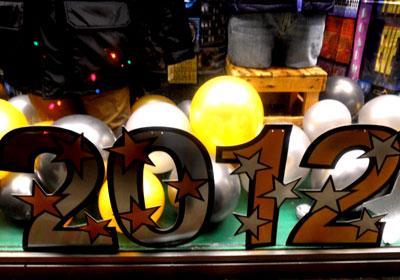Seasons by the Sea: Good Year, Good Health

Do you think of New Year’s Eve as a time to reflect on the past year, make resolutions to improve your life and the lives of others, or as an excuse to be as debauched as possible, drink too much, stay up late, and make a fool of yourself? Yeah, me too.
New Year’s Eve and New Year’s Day are the most celebrated holidays throughout the world. How and when did they begin? The earliest recorded festivities in honor of a the arrival of a new year date back 4,000 years to ancient Babylon. It was originally celebrated in late March, on the first new moon of the vernal equinox. This was the day that had an equal amount of sunlight and darkness. Civilizations around the world developed increasingly sophisticated calendars, usually pinning the first day of the year to an agricultural or astronomical event.
The early Roman calendar, created by Romulus, founder of Rome, consisted of 10 months or 304 days. A later king, Numa Pompilius, is credited with adding the months of Januarius and Februarius. Over the centuries, the calendar fell out of sync with the sun. So in 46 B.C. Julius Caesar decided to do something about it. After consulting astronomers and mathematicians, he created the Julian calendar, which closely resembles the Gregorian calendar used by most countries today. Caesar instituted Jan. 1 as the first day of the year, partly to honor the month’s namesake, Janus, the Roman god of new beginnings. Janus had two faces, one facing backward, the past, and one facing forward to the future. The day was celebrated by decorating homes with laurel leaves, offering sacrifices to Janus, exchanging gifts, and last but not least, having raucous parties.
How is New Year’s celebrated around the world? In most countries it involves lots of fireworks, plenty of toasts and family gatherings, feasts, and lots of drinking. There are also some pretty interesting customs and superstitions. In Italy, red underwear is worn for good luck and old things are thrown out the window. Lasagna is considered a good luck meal, macaroni, not. In Spain, red underwear is also considered good luck, as is eating 12 grapes, one for each chime of the clock at midnight, with a wish made for each grape consumed. This 12-grape ritual is also practiced in Costa Rica, Chile, Brazil, and Mexico. In Costa Rica, some folks grab a piece of luggage and run around the streets with it in the hope of great adventures and new trips in the coming year. Brazilians wear white and eat lentils.
In the Philippines wearing clothing with circular patterns such as polka dots should bring money. Bright colors show enthusiasm for the coming year and tossing coins at midnight attracts wealth. Shaking coins in a metal casserole brings good luck, jumping up and down will make you taller, and making a lot of noise will scare away evil spirits.
The Germans enjoy massive fireworks displays and tell fortunes by dropping molten lead into cold water. I do not recommend this activity at home. If you touch a chimney sweep this will bring luck, as will consuming jelly doughnuts and marzipan pigs.
In Iceland and Canada and many other countries there will be a satirical TV show making fun of politicians, artists (?!), and business people. Then neighbors all get together around a bonfire and watch fireworks.
Some traditions are quite sweet. In Belgium farmers go outside to wish their animals a happy new year. In the cities and towns all bus service is free, and a company called the Responsible Young Drivers taxi service gets all the revelers home safely.
An old superstition in France was that the wind direction on New Year’s Eve would predict trends for the following year. Wind blowing east meant a good year for fruit, blowing west a good year for fish and livestock, blowing south meant good weather all year, and blowing north meant crop failure. They also believed that all old wine had to be consumed by Jan. 3. I imagine that if the wind was blowing out of the north on Dec. 31, this would not be hard to accomplish.
The Russians believed that if a man was first to enter your home on New Year’s Day, the rest of the year would be good. The Japanese clean house all day to welcome Toshigami, the new year’s god. Buddhist temples ring bells 108 times to represent the 108 defilements that people have in their mind.
What are some of the foods consumed on New Year’s Eve and New Year’s Day? In Lebanon tabouleh, hummus, and kibbeh are enjoyed after the fireworks display. In Spain the meal usually includes shrimp and lamb or capon. Estonians enjoy pork with sauerkraut, potato salad with beets, and gingerbread. In the Netherlands apple turnovers and apple fritters are served for dessert and the Greeks enjoy Basil’s pie, or vassilopita.
I like the American Southern tradition of black-eyed peas — Hoppin’ John — for good luck. It’s so much simpler than capons and marzipan pigs.
However you celebrate, whether simply or elaborately, with hearty partying or earnest resolutions, I think the French sum it up best with the toast “Bonne année, bonheur, santé, amour, argent,” good and happy year, happiness, health, love, and money.
